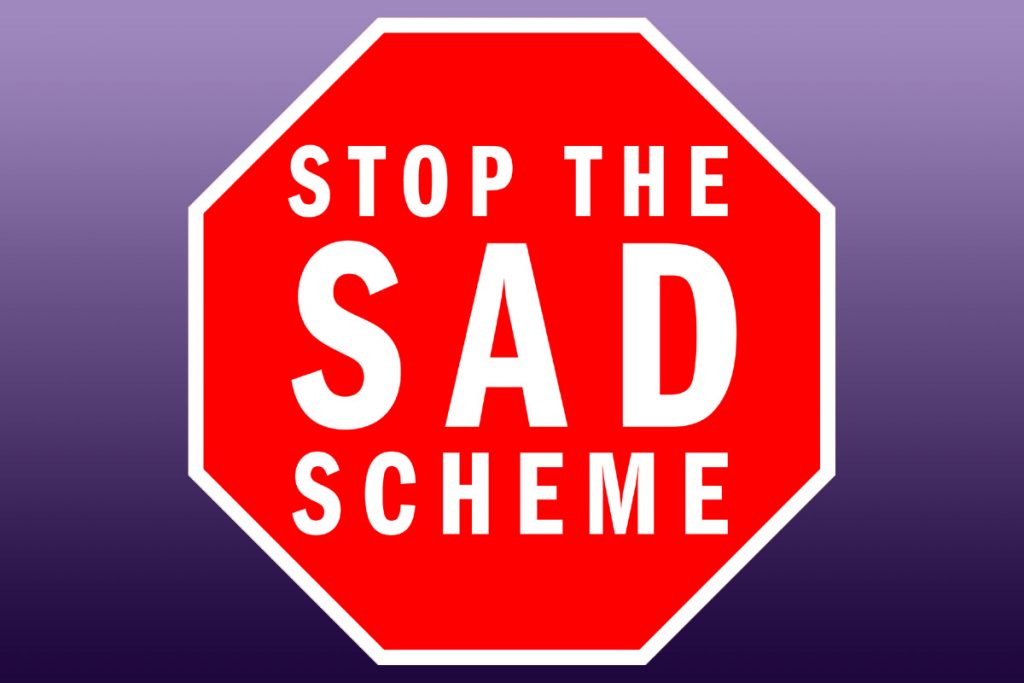SAD Scheme Lawyers Sanctioned for Judge-Shopping–Dongguan Deego v. Schedule A
This ruling involves two SAD Scheme patent cases brought by Dongguan Deego Trading Co., Ltd., represented by the Getech Law LLC law firm.
The first action was filed before Judge Tharp in the Northern District of Illinois. Judge Tharp rightly asked the plaintiff to justify joinder per 35 USC 299. In response, the plaintiff dismissed all of the defendants but one. In dismissing the other defendants, Judge Tharp ordered: “Plaintiff is advised that should it seek to reassert the same claim against any of the original defendants in this case, it must file a new case and indicate on the civil coversheet that the case is related to this case.”
The second action was filed in the Western District of Pennsylvania. It includes 10 defendants who the rightsowner voluntarily dismissed in the first action, and the filing did not indicate on the coversheet that it was related to the N.D. Illinois action. The W.D. Pa. judge granted the ex parte TRO (whoops), but when the twice-sued defendants appeared, the W.D. Pa. judge transferred their claims back to Judge Tharp in N.D. Ill.
Caught red-handed, the plaintiff’s lawyers explained to Judge Tharp that they refiled against the 10 defendants in W.D. Pa. “because that district court has a favorable approach in terms of joinder” (cleaned up). Points for honesty, deductions for a blatant lack of ethics and disregard for the integrity of the court system.
Judge Tharp did not appreciate the rightsowner’s end-run, saying (cleaned up):
this was clearly an episode of not just forum shopping but also contravention and disregard for the Court’s orders. The Court also found, as a factual matter, that the plaintiff’s failure to designate the cases as related was not a simple mistake. Because the plaintiff had made a deliberate, strategic decision not to brief joinder and instead live with the consequences of voluntarily dismissal, the Court found it unlikely that its order had been simply missed or misconstrued or neglectfully not taken into account.
In the latest ruling, he reiterates that plaintiff’s counsel engaged in sanctionable conduct. Judge Tharp dismissed the 10 defendants and will award attorneys’ fees.
Judge Tharp enumerates three different bases that allow him to impose sanctions for the rightsowner’s end-run:
28 U.S.C. § 1927. This sanction applies to vexatious multiplication of litigation. “By blatantly violating a direct court order in an intentional, strategic attempt to manipulate procedural rules to curate a favorable forum, the plaintiff at the very least exhibited reckless and indifferent disregard for the law.”
Rule 11. “The plaintiff’s representation, communicated in its civil cover sheet, that the Pennsylvania action was unrelated to the original action was not “objectively warranted by existing law or a good faith argument for [its] modification.”…. Moreover, the plaintiff flatly violated Local Rule 40 of the Western District of Pennsylvania” [which defines when cases are related].
Court’s Inherent Authority.
The plaintiff’s flagrant manipulation of judicial fora to sidestep adverse joinder rulings, coupled with its reckless (at a minimum) disregard for the Court’s explicit order designed to prevent such manipulation, warrants attorneys’ fees and dismissal of the overlapping defendants with prejudice…
The need to deter future misconduct further justifies the sanction. Violations of court orders that span multiple jurisdictions are difficult to detect, particularly in Schedule A cases where forum shopping is rampant and defendants rarely appear. Such misconduct results in a disproportionate drain on court resources, outsized harm on non-appearing defendants, and, therefore, an enhanced need for robust deterrence.
The court didn’t yet determine the total amount of attorneys’ fees being awarded, but it should be tens of thousands of dollars.
 In summary, Judge Tharp has sharp words about this situation:
In summary, Judge Tharp has sharp words about this situation:
blatant forum shopping has become a regrettable staple of “Schedule A” cases, mass-counterfeit lawsuits against semi-anonymous online retailers who rarely appear and thus provide unprecedented leeway for plaintiffs to file, amend, dismiss, and re-file until they find a judge willing to permit joinder of the previously dismissed defendants in a single action
His sanctions surely won’t stop the bad behavior by SAD Scheme plaintiffs, but it’s a start.
Case Citation: Dongguan Deego Trading Company, Ltd. v. Junyao-US, 1:25-cv-04962 (N.D. Ill. July 31, 2025)
* * *
A few more items of note regarding the SAD Scheme.
President Trump Adopts the SAD Scheme 😢
President Trump’s team is using the SAD Scheme. See the complaint. This is the first time I’ve seen a Trump-affiliated entity adopt the practice, but I didn’t check if there are other cases. The Boies Schiller law firm filed this SAD Scheme lawsuit.
From my perspective, the SAD Scheme fits Pres. Trump’s brand perfectly: the SAD Scheme disrespects the rule of law, and so does Pres. Trump. The SAD Scheme is a microcosm of the broader US trend to dispense with due process. Of course Trump would love that.
New “Bar Association” Seeks to Normalize the SAD Scheme
Some SAD Scheme rightsowners’ lawyers have launched a website announcing a so-called bar association, the “Strategic Alliance for Fair Ecommerce,” a/k/a the “SAFE Bar Association.” (No link love from me, sorry). SAFE’s website seeks to normalize the SAD Scheme by…well, I’m not really sure because none of the website’s contents made sense to me, but I’m not in the target audience.
The website offers a list of seven “best practices” for SAD Scheme litigation. The website doesn’t explain who developed these “best practices” or who was consulted. For all we know, they are the product of a 2 minute ChatGPT session.
Most of the so-called “best practices” just restate what lawyers must do to comply with Rule 11. This is a major move only because the SAD Scheme has led to some lawyers treating Rule 11 compliance as optional. So if the “best practices” get SAD Scheme lawyers to follow Rule 11, yay I guess.
One so-called “best practice” recommends that each SAD Scheme case name no more than 100 defendants. Where did that number come from, and why is it better than 10 or 50 or 200 or 1M? 🤷♂️ The “best practice,” without any evidence, simply says that 100 defendants “balances judicial efficiency and allows practical case management.” From whose perspective? The joinder statutes literally tell us the right number of defendants–only defendants who are actually affiliated or working together, not just engaging in parallel independent acts involving the same plaintiff. I expect 100 always exceeds that number…by a lot. I’m also wondering if the “bar association” inaugural members have ever filed SAD Scheme cases with over 100 defendants, and how recently…
Otherwise, the “best practices” seem like an attempt by some rightsowners’ lawyers to throw other lawyers under the bus by claiming that they were “bad” lawyers if they don’t stick to the list. Thus, rightsowners’ lawyers can tell judges that the SAD Scheme community is trying to clean up its act. I don’t think the list is persuasive on either front but again, I’m not in the target audience. I think the SAD Scheme is never legitimate, so intra-plaintiffs’ bar squabbling doesn’t solve any problem. You can’t legitimize bad practices by condemning even worse practices.
In addition to the “best practices” list, the SAFE Bar Association website also includes a “resources” page with a total of two articles and four cases. You can guess the criteria used to curate this resource list.
The two articles (again, no link love here) have one thing in common: both directly attack my SAD Scheme article. I don’t mind the heat, but I do have a major problem with the piece titled “Schedule A cases. Not sad at all.”
This student note was authored by a Chicago-Kent 2L, and it won a writing competition by a student-run journal last year. During all relevant times, I believe the student was clerking for a law firm that filed SAD Scheme cases. However, the note does not disclose this fact. In other words, the note seeks to normalize the (dubious) litigation practices of its author’s employer without disclosing the employment status. I’ve often wondered if the writing competition judges (all students themselves) would have selected the note for an award if they knew this fact. At minimum, the omitted disclosure may change how readers evaluate the note.
Help Me Organize the Standing Orders Regarding the SAD Scheme.
Several judges have SAD Scheme Standing Orders, but I can’t systematically find and curate them. A bleg: if you know of any judge’s standing orders on Schedule A/SAD Scheme, please email me the URL. I need your help collecting ’em all! 🙏
* * *
Prior Blog Posts on the SAD Scheme
- Judge Ranjan Cracks Down on SAD Scheme Cases
- Because the SAD Scheme Disregards Due Process, Errors Inevitably Ensue–Modlily v. Funlingo
- SAD Scheme-Style Case Falls Apart When the Defendant Appears in Court—King Spider v. Pandabuy
- Serial Copyright Plaintiff Lacks Standing to Enforce Third-Party Copyrights–Viral DRM v 7News
- Another N.D. Ill. Judge Balks at SAD Scheme Joinder–Zaful v. Schedule A Defendants
- Judge Rejects SAD Scheme Joinder–Toyota v. Schedule A Defendants
- Another Judge Balks at SAD Scheme Joinder–Xie v. Annex A
- Will Judges Become More Skeptical of Joinder in SAD Scheme Cases?–Dongguan Juyuan v. Schedule A
- SAD Scheme Leads to Another Massively Disproportionate Asset Freeze–Powell v. Schedule A
- Misjoinder Dooms SAD Scheme Patent Case–Wang v. Schedule A Defendants
- Judge Hammers SEC for Lying to Get an Ex Parte TRO–SEC v. Digital Licensing
- Judge Reconsiders SAD Scheme Ruling Against Online Marketplaces–Squishmallows v. Alibaba
- N.D. Cal. Judge Pushes Back on Copyright SAD Scheme Cases–Viral DRM v. YouTube Schedule A Defendants
- A Judge Enumerates a SAD Scheme Plaintiff’s Multiple Abuses, But Still Won’t Award Sanctions–Jiangsu Huari Webbing Leather v. Schedule A Defendants
- Why Online Marketplaces Don’t Do More to Combat the SAD Scheme–Squishmallows v. Alibaba
- SAD Scheme Cases Are Always Troubling–Betty’s Best v. Schedule A Defendants
- Judge Pushes Back on SAD Scheme Sealing Requests
- Roblox Sanctioned for SAD Scheme Abuse–Roblox v. Schedule A Defendants
- Now Available: the Published Version of My SAD Scheme Article
- In a SAD Scheme Case, Court Rejects Injunction Over “Emoji” Trademark
- Schedule A (SAD Scheme) Plaintiff Sanctioned for “Fraud on the Court”–Xped v. Respect the Look
- My Comments to the USPTO About the SAD Scheme and Anticounterfeiting/Antipiracy Efforts
- My New Article on Abusive “Schedule A” IP Lawsuits Will Likely Leave You Angry
- If the Word “Emoji” is a Protectable Trademark, What Happens Next?–Emoji GmbH v. Schedule A Defendants
- My Declaration Identifying Emoji Co. GmbH as a Possible Trademark Troll



Pingback: Judge Kness: the SAD Scheme "Should No Longer Be Perpetuated in Its Present Form"-Eicher Motors v. Schedule A Defendants - Technology & Marketing Law Blog()